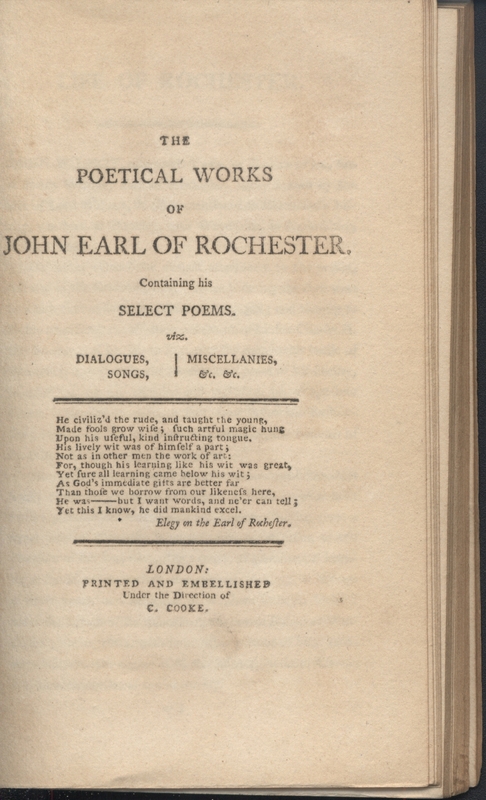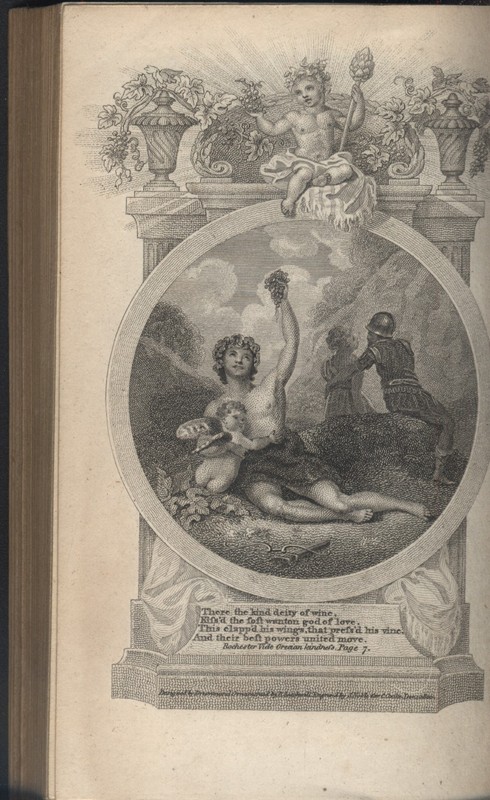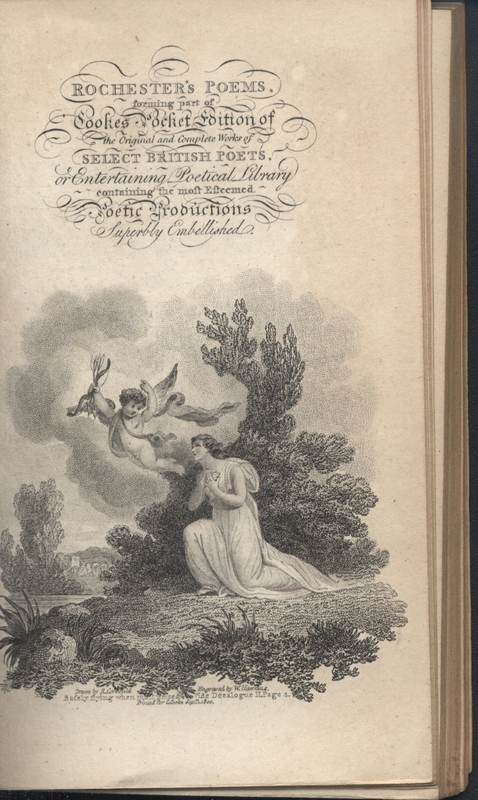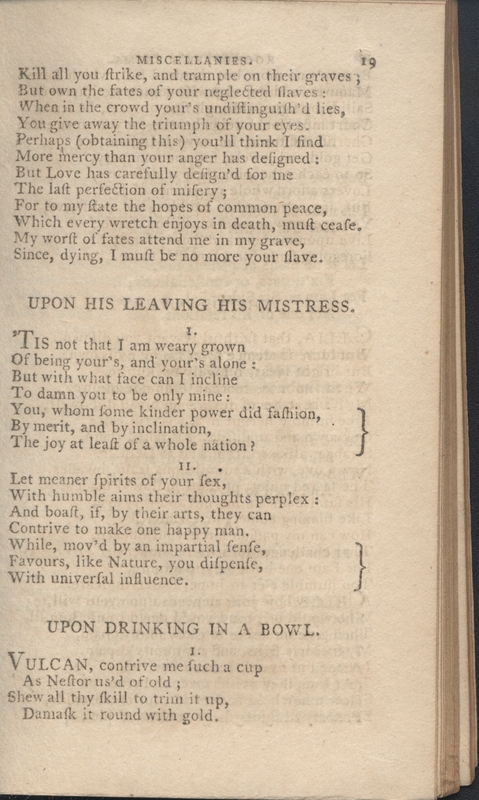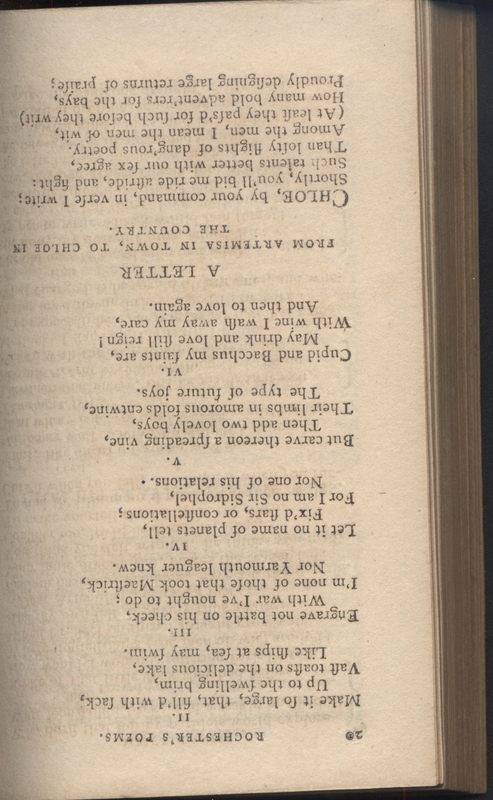Cooke's Pocket Edition of Select British Poets, Vol. 6 (1800)
Cooke's Pocket Edition of Select British Poets, Vol. 6 (1800)
“The Size of the Volumes that compose this Pocket Library, is Octo-decimo, or Eighteens ... It therefore forms a happy medium between the Extremes of diminutive Inconvenience and ponderous Inutility; and is thereby rendered as commodious for the Pocket, as it is ornamental to the Book Cafe. Each Volume, from its convenient Size, forms an agreeable Travelling Companion, adapted for Amusement at the Fire-side, and equally commodious for passing leisure Hours, when Nature and the Season invite us abroad.”
-Charles Cooke (Plan and Catalogue 1)
In his book The Most Disreputable Trade: Publishing the Classics of English Poetry 1765-1810 English professor Thomas F. Bonnell describes the boom of pocket editions of poetry which began to appear in England around 1765 as “a publishing phenomenon” (Bonnell 2). The sheer volume of poetry published at the time represents a clear desire on the part of the British reading public for collected works and easy access to the growing national canon of poets. “Readers were hungry for such books,” Bonnell writes, “and publishers were eager to gratify their appetite” (Bonnell 1). Mass appeal and a wide readership create demand, and the publishers of the day fulfilled this demand in various ways. One of the more creative publishers was a man named Charles Cooke, an innovative and aggressive publisher with a keen understanding of what the literary public wanted, and how to make money from it.
As the above quote illustrates, Cooke promised something to outshine his ample competition. He set out to create a reprint series, first of novels, then later one of poetry, one of sermons, etc., which would be of a uniform size and appearance, portable enough to be carried about but decorative enough to be attractive editions to a library. He employed “a purposely manufactured weave Vellum-paper, so well manufactured, and from such excellent Materials, that it never varies, but always preserves a uniform, beautiful Appearance of Colour and Texture, and, when printed on, has the additional Lustre of being highly glazed and hot-pressed” (Plan and Catalogue 1). His advertisements, which were numerous and papered the inside of each individual volume, stressed the advantages which his collection held over others and reassured the customer that the price was not a reflection of low quality but rather his own desire to create the best product for the lowest cost.
The rise of middle-class readership made collections such as Cooke’s Pocket Editions successful enterprises. The demand was there for books which were made for those in the lower classes to consume, and men like Charles Cooke understood the specific needs of this audience. Whereas other creators of more sophisticated collections, such as John Bell, opened their collections with poets such as Milton (in the case of Bell), Cooke, who would naturally include Milton later, opened with more popular (and less difficult) authors such as James Thomson (Bonnell 248). In short, “it was Cooke’s explicit intention ‘To adapt the Work to all Classes of Readers’” (Bonnell 237).
It is Cooke's Pocket Edition of Select British Poets that this project concerns, with a special focus on Volume 6, which contains the works of John Wilmot, 2nd Earl of Rochester. The University of Victoria, thanks to the enormous generosity of Maurice Yacowar, are fortunate enough to house several works from this series. We do not have the full set, only eleven of the fifty-six volumes of poetry he eventually published. However, combined with Bonnell’s excellent research and a pamphlet written by Cooke himself, Rochester’s volume becomes a prime example of Cooke’s contribution to eighteenth and nineteenth-century literary culture, and his intention to marry the desire for a national, patriotic canon of writers and a literary education accessible to those in the middle classes, along with his unusually keen mind for creating monetary opportunities in the world of reprint publishing.
“Thus began a vast reprint operation that turned Cooke into a full-service purveyor of English classics … in this respect he was an ‘orthodox-innovator’, to borrow a character type coined by Stephen Skowronek to describe someone who adopts the agenda of a path-breaking predecessor, but presses ahead with the idea more systematically and persistently than its earlier champion was able to do. Among eighteenth-century English booksellers he was ‘one of the few true geniuses'”.
-Thomas F. Bonnell (Bonnell 227-228)
I. Embellishments
“Illustrated with SUPERB EMBELLISHMENTS, possessing an uncommon degree of beauty and high finishing, taken from the Paintings of Artists of the First Eminence, and executed by Engravers of no less celebrity.”
-An advertisement written by Charles Cooke for Cooke's Pocket Edition of Select British Poets (Bonnell 229)
Charles Cooke believed that paintings were the perfect accompaniment to poetry. His editions were all extensively illustrated, the art included to “to combine the sublime and refined Ideas of the Poet, with the picturesque and elegant Representations of the Artist; and to present at once, to the Mind and the Eye, the most beautiful and striking Objects, in all the Harmony of Verse and Force of Colouring” (Plan and Catalogue 1). Cooke’s pocket editions were more extensively illustrated than any other of the major poetry collections of the day, the series of select poets along containing “127 Scenic Representations, 56 Vignette Frontispieces, and 26 portraits” (Bonnell 255). The section of the volume devoted to the individual poet would contain both a frontispiece and a title page with a vignette frontispiece.
The examples I have included in this section are from the section of volume 6, the volume containing works of Rochester. The frontispiece of his section is an illustration of an encounter between Bacchus and Cupid from Rochester’s poem “Grecian Kindness” (Cooke’s Pocket Edition 7). The vignette on the title page continues this theme, representing another line from the same poem (Cooke’s Pocket Edition 4). The pastoral nature of these engravings is a constant throughout the published collections of Cooke. “Cooke launched his series with poets whose pictures, scenery, and imagery were more amenable to constructions of British nationalism and evocative of a bardic interplay with landscape. ‘Bardic nationalism’, as Katie Trumpener has shown, was tied to a sense of the landscape and its historical depth, a sense of place repeatedly conveyed by Cooke’s illustrations” (Bonnell 248). Cooke’s enterprise was irrevocably tied to feelings of patriotism and nationalism, situated as he was in the attempt to create a canon of classic British literature. Cooke’s own influence in the engravings is evidenced by his constant bibliographic reminders that it is he who supervises the artistic process: his name sits alongside the artistic and engravers on every frontispiece and each title page boasts “‘PRINTED AND EMBELLISHED Under the Direction of C. COOKE’, [reflecting] his genuine engagement in the process” (Bonnell 255).
Further evidence of Cooke’s pride in his illustrations is given in his pamphlet Plan and Catalogue of Cooke's Uniform, Cheap and Elegant Pocket Library (1794), which I will be discussing later. When explaining his reasons for the emphasis on art in his literary collections, Cooke informs the reader that the originals from which his prints are taken will be “submitted to inspection, free of expence, from the Hours and Nine to Three, at the Proprietor's Exhibition Room, in Paternoster Row” so that the readers will be able to more fully appreciate the “Superior Execution of the Embellishments” (Plan and Catalogue 4). As seems to be the case with most of the actions Cooke takes with his publications, his motives are both sentimental and capitalist. He clearly wishes the art to be seen and appreciated in all its glory, and is proud of the work of the artists he commissions. However, he also cannot seem to pass up a chance to get the public into his shop, possibly so that he may make the case for further purchases in person. Once more, we see Cooke’s deep love for the finer art in concert with his kind of business savvy. Showcasing these artworks in his shop is certainly a marketing ploy, but it also shows us the sincere appreciation he had for art. Illustration is no stranger to printed texts, but, as the statistics I gave earlier show, Cooke commissioned far more art than was strictly necessary for his works, and he did employ more engravers than any other publisher, which eventually “helped to provide ‘the first steady market for the work of English engravers and artists’” (Bonnell 255).
II. Rochester's Poems
“…many of Rochester’s poems were omitted for violating the ‘purest principles of moral rectitude and social virtue.’”
-Cooke’s rational for his careful selection of Rochester’s canon, as quoted in The Most Disreputable Trade (Bonnell 246)
When I was first brought into this exhibit, I was asked to chose a book from Special Collections that might interest me. Naturally, as a life-long lover of the Earl, the first thing I did was try to discover whether they had any printed versions of Rochester’s works. The first book I found was a collection published by Edward and Knibb in 1821, which I soon discovered was merely a reprint, illustrations and all, of volume 6 of Cooke's Pocket Edition of Select British Poets. Luckily for me in storage with Special Collections was a large set of said series. Even more fortunately, one of those contained the original printing of Cooke’s volume on Rochester.
When I found myself with an early nineteenth century printing of the (selected) works of John Wilmot, 2nd Earl of Rochester, notorious spark and libertine, two questions were foremost in my mind. The first, which of his poems will they deem appropriate for the public? And second, have they made any alterations to his poems in order to be able to print them? The answer to the first question was easily solved by a quick look at the table of contents. Works such as “The Imperfect Enjoyment”, which is about premature ejaculation, and “A Ramble in St. James’ Park”, a pornographic fantasy about a night time walk through the famous park, are naturally absent, along with less notable works who cannot be redeemed with a word change here or there. The answer to the second, however, required a bit more searching. It did not take long, however, before I found solid example of clear editorial interference.
“Upon Drinking in a Bowl”, alternatively known as “Anacreontic from Ronsard” (correct attribution being a constant source of trouble for a poet whose work was never formally published during his lifetime and for whom our primary sources of his texts are incomplete, often anonymously circulated manuscripts), is a poem about the enhancement of sexual desire by the consumption of alcohol. The speaker asks Vulcan to fashion him a cup, one large enough to slake his thirst. Importantly, he requests that the cup be engraved with the image of two boys in an amorous entwine, “The type of future joys” (Lyons 60, Veith 52). The final lines in the poem state the speaker's intent, “With wine I wash away my cares, / And then to cunt again” (Lyons 60, Veith 52). I state this phrasing as fact because I am bolstered by the body of scholarship on Rochester. As my two specific references, I have chosen The Complete Poems of John Wilmot, Earl of Rochester (1968), collected and edited by David M. Veith, and Rochester: Complete Poems and Plays (1993), collected and edited by Paddy Lyons. Veith was the first to publish a critical scholarly edition of Rochester’s canon, and his book is often considered to be the definitive collection. However, given the issues of attribution and copy text I mentioned above, I thought it best to include a second opinion, and who better to choose than someone whose scholarship actively challenges Veith’s work, as Lyons does. In both their editions, which claim fidelity to their source texts, the final line of “Upon Drinking in a Bowl” contains the word “cunt.” However, as it evident in the photographs contained in this section, Cooke’s version replaces that with the word “love.”
The substitution itself is quite clever. It turns the focus of the poem from carnal delights to romance, and shifts lasciviousness to sentimentality. The change replaces a drunken (bisexual) letch with a tipsy romantic, making it appropriate enough to include in a collection such as Cooke’s. The change, however, was likely not made by Cooke himself. It is posited in Lyons’ edition that since the substitution first appears in Jacob Tonson’s 1691 collection of Rochester’s works, it was likely made by him (Veith viii). It is impossible to know whether Cooke was aware of the original line. Aware or not, though, Cooke surely knew about Rochester’s reputation and the nature of his less publishable works. I am interested, therefore, in his decision to include Rochester among poets such as Milton, Dryden, even Shakespeare. No direct evidence exists on this point, but it is clear from his often articulated intentions in creating this collection that he deemed Rochester worthy of a place in the national canon of distinguished poets. “‘[N]ot any will gain admission but such as have been stamped with universal approbation,’ vouched the publisher” (Bonnell 241).
III. Plan and Catalogue of Cooke's Uniform, Cheap and Elegant Pocket Library
“As a complete Library, comprising all the most esteemed works in the English language, each printed on the same Type, on the same Size, on the same Paper, and embellished by the same. Artists, was never before attempted in this Kingdom: it is presumed that the advantages resulting from it will be evident to the Public; particularly as each Edition of the respective works will excel in Elegance any that have preceded them, and be reduced to less than Half the Expence of the most common and unadorned editions."
- Charles Cooke (Plan and Catalogue 3)
In every piece of writing, from his advertisements to his prefaces to this pamphlet on his publishing plans, Charles Cooke consistently maintains the ideals for his published collections. He wants them to be complete and correct, he wants them to be attractive and decorative, and he wants them to be cheap. Not cheaply made, but cheap to buy. Cooke was a businessman and made no secret of his business model. The pamphlet I am discussing, Plan and Catalogue of Cooke's Uniform, Cheap and Elegant Pocket Library, was self-published by Cooke in 1794 and is a manifesto of sorts. It details his plan for this series, which authors he will include, how subscription will function, how much the books will cost, and what their physical attributes will be. However, the pamphlet also illuminates the twin qualities that made Cooke such a successful innovator; he lays out his sentimental reasons for embarking upon this extremely ambitious enterprise, while simultaneously revealing the extent of his ability to generate the most capital gain out of the venture. This pamphlet not only provides context for the series but also helps illustrate why this series of books remains a fascinating case study in the history of published literature.
Cooke was not shy about comparing his works to those of his competitors. Time and time again when discussing his planned series in the pamphlet, he disparages other similar collections when discussing the merits of his own. For instance, when giving examples of how he will lessen the cost of the finished product without sacrificing quality, he tells the reader he will ignore standard printing practices “by deserting the usual mode of printing on types disproportionably large, with preposterous margins, considerable spaces between the lines, and unnecessary blanks before and after the chapters, heads, &c. by which means former works have been enhanced to a double expense, without embracing one good purpose for their end” (Plan and Catalogue 3). Uniformity of size and shape is another quality which he brings up often as one of the chief virtues of his volumes, “The Octo-decimo size in all the works being invariably adhered to, the Library, therefore, appears with that Uniform Elegance which a collection of volumes of promiscuous sizes cannot exhibit; and the volumes, from their uniformity, are infinitely more decorative to the library than an arrangement in the promiscuous sizes of Quarto, Octavo, Duedecimo, &c” (Plan and Catalogue 4).
It is this uniformity of size that leads to one of his more brilliant ideas in terms of monetization of the endeavour. Along with subscriptions sales, and the makeshift gallery he created in his bookshop discussed in a previous section, Cooke managed to create a third line of income from his series by selling bookcases, specially made to house his volumes. “The uniformity of the works through the whole of the Library, has enabled the Proprietor to adapt to them Portable Bookcases. He has also had another Bookcase constructed, which occupies a space of only seven inches from the back of the room, a circumstance which, for small apartments, must be peculiarly convenient and desirable; nor is it less eligible for a room of great extent” (Plan and Catalogue 4). In short, Cooke had not only made literature available in an attractive package to a wide range of incomes, but he made a bookcase in which to house them, which would be suitable to a room of any size, and was naturally available for purchase “at the warehouse of the Proprietor, who engages to supply the Nobility and Gentry with Bookcases upon the same plan, adapted to any space required” (Plan and Catalogue 4).
However, while Cooke’s writings may betray his shrewd business acumen, and ability to create opportunities for revenue where others may not have dreamt them, they also show true ideals beneath a capitalistic venture. Cooke’s library was as inclusive as his desired audience, elevating the works of men like Rochester to a high level by placing them alongside men like Milton, Dryden, and Shakespeare. He states, again and again, his desire for a complete British canon, showcasing the genius and talent which, to him, represented the pinnacle of national achievement. Moreover, his consistent emphasis on low cost shows his desire for his works to reach as wide an audience as possible. As it often did when it came to Cooke’s efforts, this aspiration is both financially and sentimentally motivated. True, he wished for the widest possible revenue stream. However, he also wanted to make these works available to all, so that his readers, no matter their income or standing, would have access to these essential, British works, so that they would be educated and elevated by the shining examples of Britain’s literary capacity.
“the Proprietor flatters himself that his Editions will again Admission into the Cabinets of the Curious, the Libraries of the Literati, and the most fashionable of the present age.”
-Charles Cooke (Plan and Catalogue 2)
IV. Works Cited
Bonnell, Thomas F. The Most Disreputable Trade: Publishing the Classics of English Poetry 1765-1810. Oxford University Press, 2008.
Cooke, Charles, editor. Cooke's Pocket Edition of Select British Poets. Charles Cooke, 1794-1805.
Cooke, Charles. Plan and Catalogue of Cooke's Uniform, Cheap and Elegant Pocket Library. Charles Cooke, 1794.
Lyons, Paddy, editor. Rochester: Complete Poems and Plays. J. M. Dent, 1993.
Veith, David M., editor. The Complete Poems of John Wilmot, Earl of Rochester. Yale University Press, 1968.
KA/Fall 2016

